#rocketengine
5 Likes
2 Shares
The Entire Soviet Rocket Engine Family Tree
"Today we’re going to actually straighten out the confusing family tree of the Soviet rocket engines by drawing out a super comprehensive chart of almost every engine that has flown to orbit while also walking you through some INCREDIBLE stories and fun anecdotes behind these engines."
➡ https://www.youtube.com/watch?v=Y-xyXDiC92s
#Rocket #RocketEngine #Rockets #RocketEngines #Space #Soviet #SovietUnion #Russia #Engineering
2 Likes
Japanese Rocket Engine Explodes: Continuously and On Purpose
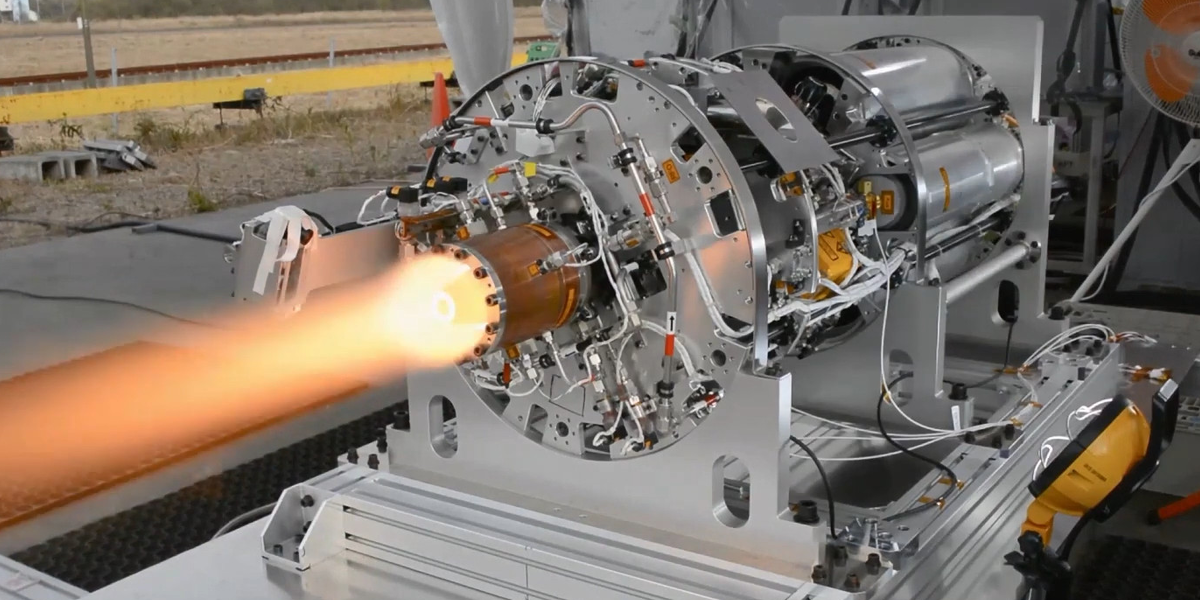
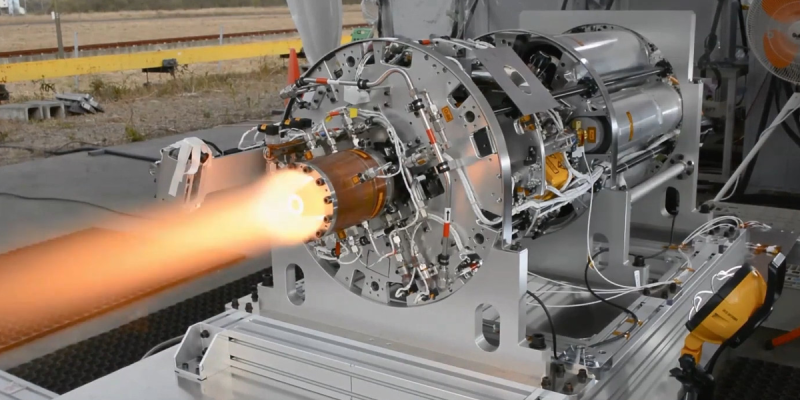
Liquid-fuelled rocket engine design has largely followed a simple template since the development of the German V-2 rocket in the middle of World War 2. Propellant and oxidizer are mixed in a combustion chamber, creating a mixture of hot gases at high pressure that very much wish to leave out the back of the rocket, generating thrust.
However, the Japan Aerospace Exploration Agency (JAXA) has recently completed a successful test of a different type of rocket, known as a rotating detonation engine. The engine relies on an entirely different method of combustion, with the aim to produce more thrust from less fuel. We'll dive into how it works, and how the Japanese test bodes for the future of this technology.
Deflagration vs. Detonation
Humans love combusting fuels in order to do useful work. Thus far in our history, whether we look at steam engines, gasoline engines, or even rocket engines, all these technologies have had one thing in common: they all rely on fuel that burns in a deflagration. It's the easily controlled manner of slow combustion that we're all familiar with since we started sitting around campfires.
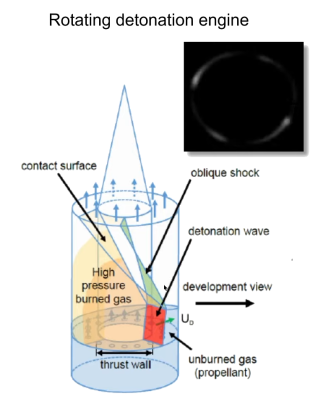 A diagram of the JAXA rotating detonation engine, showing the intended operation in which the shock wave from detonating fuel travels around the engine in the annular channel to continue the combustion cycle. Source: JAXA
A diagram of the JAXA rotating detonation engine, showing the intended operation in which the shock wave from detonating fuel travels around the engine in the annular channel to continue the combustion cycle. Source: JAXA
However, there are potential efficiency gains to be had by combusting fuel in a detonation instead. This is where the combustion creates a shock wave that travels faster than the speed of sound that rapidly propagates the detonation reaction further, and comes with a huge pressure increase to boot. The key advantage of burning fuel in this manner is that there is more energy to be gained from that huge pressure increase. Thus, by releasing more energy from the same amount of fuel, engines operating on a detonation-based process could theoretically be more energy efficient.
There are several issues with operating an engine on a detonation-based cycle, however. It can be difficult to sustain a continuous detonation reaction. Additionally, large spikes in temperature and pressure from the detonation process and the associated shockwaves can easily damage or destroy parts made of even very tough materials. Thus far, engineers in many fields have struggled to tame and control detonation processes to the point where they can be used successfully.
The rotating detonation engine consists of a combustion chamber that has a annular, ring-type construction. In this ring, fuel and oxidizer is injected, and ignited in such a way to detonate the mixture. The aim is for the shockwave of this detonation to travel around the ring-shaped combustion chamber causing further detonations as it goes in a continuous cycle.
Getting the concept to work has proved difficult; despite the concept being first developed in the 1950s at the University of Michigan, it was only in recent years that engineers had successfully demonstrated a rotating detonation engine in continuous operation. A team at the University of Central Florida demonstrated a hydrogen-oxygen fueled engine in 2020, producing up to 200 lbf (890 N) of thrust in testing. The feat was achieved through careful tuning of the size of the jets that inject the propellants to get the mixture just right for controlled detonation to go on. Get the mixture wrong, and the fuel will burn in a slower deflagration, with no benefits to thrust or efficiency.
Japan's Live Test
Unlike the experiment by the University of Central Florida, the Japanese effort involved launching an actual rocket. The test used a standard sounding rocket with a conventional engine to launch the test payload hundreds of kilometers above the Earth, with the second stage of the rocket mounted the rotating detonation engine. The mission took place using sounding rocket S-520-31, launched from the JAXA Uchinoura Space Center on July 27, 2021.
 The JAXA rotating detonation engine in operation over Earth. Source: Nagoya University, JAXA
The JAXA rotating detonation engine in operation over Earth. Source: Nagoya University, JAXA
The second stage fired successfully, running for six seconds and producing 112 lbf (500 N) of thrust during that period, 56% of the Florida team's ground demonstrator. Data collected from the experiment confirmed that the engine operated as expected, combusting its fuel in the detonation regime.
JAXA hopes to put the technology into practical applications within five years, given the successful demonstration of the flight hardware. Built in collaboration with a team from Nagoya University, the hope is to develop the technology further to create more efficient spacecraft in future. It could find application in a variety of areas, from first stage and second stage rocket motors, to being applied to deep space missions to make the most of limited fuel resources.
The technology has come a long way in the past few years. With multiple independent groups now demonstrating working engines, it's shaken the "impossible" title that had become attached to the rotating detonation concept for half a century. Obviously, much engineering will be required to build practical engines that outperform existing designs. However, with the recent strides made in the field, there's now a spark of hope that tells us it could be done.
#enginehacks #hackadaycolumns #science #aerospace #engine #rocket #rocketengine #rocketry #rotatingdetonationengine
1 Shares
1 Comments
So How Does a Rocket Fly Sideways, Anyway?
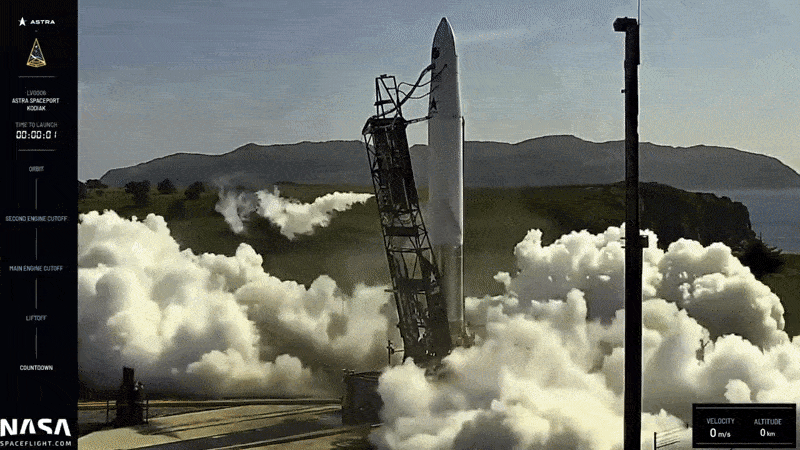
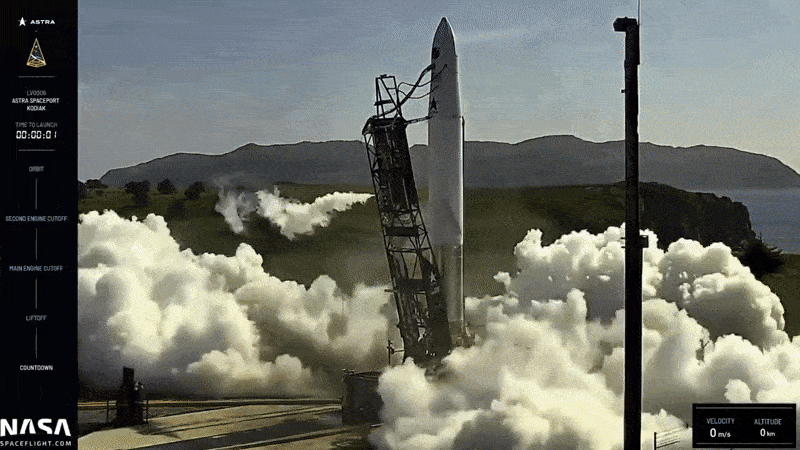
It's often said that getting into orbit is less about going up, and more about going sideways very fast. So in that sense, the recent launch conducted by aerospace startup Astra could be seen as the vehicle simply getting the order of operations wrong. Instead of going up and then burning towards the horizon, it made an exceptionally unusual sideways flight before finally moving skyward.
As you might expect, the booster didn't make it to orbit. But not for lack of trying. In fact, that the 11.6 meter (38 feet) vehicle was able to navigate through its unprecedented lateral maneuver and largely correct its flight-path is a testament to the engineering prowess of the team at the Alameda, California based company. It's worth noting that it was the ground controller's decision to cut the rocket's engines once it had flown high and far enough away to not endanger anyone on the ground that ultimately ended the flight; the booster itself was still fighting to reach space until the very last moment.
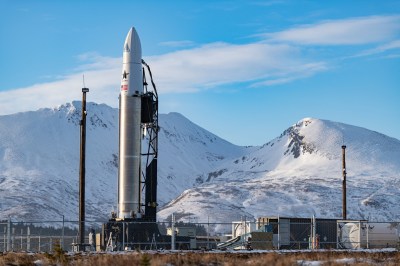 Astra's rocket on the launch pad.
Astra's rocket on the launch pad.
There's a certain irony to the fact that this flight, the third Astra has attempted since their founding in 2016, was the first to be live streamed to YouTube. Had the company not pulled back their usual veil of secrecy, we likely wouldn't have such glorious high-resolution footage of what will forever be remembered as one of the most bizarre rocket mishaps in history. The surreal image of the rocket smoothly sliding out of frame as if it was trying to avoid the camera's gaze has already become a meme online, arguably reaching a larger and more diverse audience than would have resulted from a successful launch. As they say, there's no such thing as bad press.
Naturally, the viral clip has spurred some questions. You don't have to be a space expert to know that the pointy end of the rocket is usually supposed to go up, but considering how smooth the maneuver looks, some have even wondered if it wasn't somehow intentional. With so much attention on this unusual event, it seems like the perfect time to take a close look at how Astra's latest rocket launch went, quite literally, sideways.
Perfectly Balanced
Everyone knows that sending a rocket to space is hard, but unless you've read up on the Tsiolkovsky rocket equation, you might not realize just how true that statement really is. Even if everything goes right, which is already a lot to ask for, the physics that govern chemical rockets are particularly brutal. Put in the most simplistic of terms, the "Rocket Equation" governs how much of a rocket's liftoff mass is dedicated to propellant versus what it's actually carrying. In the aerospace community, this is often expressed as a booster's payload fraction.
The Space Shuttle only managed a payload fraction of around 1.5%, while the SpaceX Falcon 9 is capable of slightly more than 4%. Astra hasn't provided detailed specifications for their current launch vehicle, but given how small it is and some back of the envelope math, we can assume it's operating at a payload fraction of not more than 1%. We can further estimate that, at the time of liftoff, the vehicle's thrust-to-weight ratio (TWR) must be quite low.
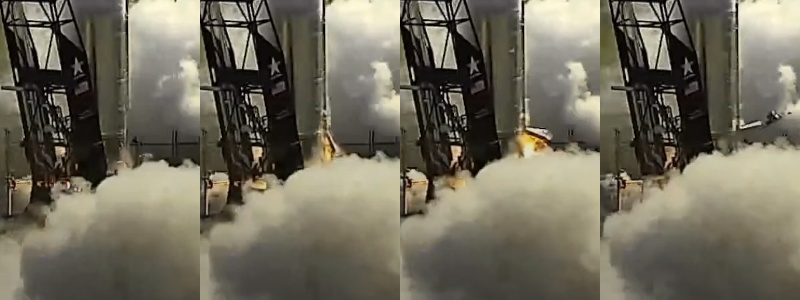 The destructive failure of one of the rocket's engines, captured in just four frames from the live video.
The destructive failure of one of the rocket's engines, captured in just four frames from the live video.
Which is precisely what we saw in the live video from the August 28th launch. Right after ignition, one of the rocket's five first stage engines failed. This reduction of thrust brought the TWR of the vehicle so close to equilibrium that, instead of climbing vertically, it entered into a remarkably stable hover. As luck would have it, the failed engine happened to be the one diametrically opposed to the launch tower, which meant the asymmetrical thrust of the remaining engines moved the vehicle laterally away from the launch pad. Had one of the other engines failed, there's an excellent chance the rocket would have struck the launcher or some other piece of ground support equipment.
The rocket, now clear of any structures and traveling horizontally, was still consuming propellant at an incredible rate. At around five seconds after engine startup, it had burned through enough fuel and oxidizer that the mass of the vehicle was once again below the total thrust of the engines. With a positive TWR, the vehicle began to climb away from the launch area, albeit at a far lower rate than normal. During the live stream, you can see the obvious confusion of the camera operator, who expected the rocket to be much higher at this point in the flight and needed to pan back down to keep it in frame.
<https://hackaday.com/wp-content/uploads/2021/08/astraslide_tracking.mp4>
As the rocket climbed higher and faster it started to look like a fairly typical launch, and after about a minute of flight time, you'd never have known how close the vehicle came to being obliterated at liftoff. Its reduced thrust and skewed ascent meant it would never make it all the way to space, but it certainly made a valiant effort.
Just before the mission elapsed timer clicked over to 2:00, an astonished member of ground control could be overheard on the live stream saying that the rocket was actually approaching its nominal downrange trajectory; a sentence that seems destined to become an Easter egg in the next Kerbal Space Program.
A Truly Remarkable Failure
It's easy to look at this launch and see it as a major setback for Astra. Indeed, the company's stock price plummeted nearly 20% when trading started on Monday morning. But while clearly not the ideal outcome, the reality is, things could have gone far worse. For one thing, the fact that the launch site was completely unscathed is nothing short of miraculous. When an Antares rocket exploded a few seconds after liftoff in 2014, it took nearly two years to repair the launchpad at a cost of approximately $20 million.
 The team at Astra was also undoubtedly able to collect valuable data about the vehicle's performance during this truncated flight. Remember, the rocket technically never failed. It was still flying strong, though not necessarily on the correct flight path, when the command to activate the flight termination system was given. At that point the rocket had flown for nearly two and a half minutes and reached an altitude of 50 kilometers (30 miles), an impressive accomplishment for a fledgling company that lofted their first vehicle just two years ago.
The team at Astra was also undoubtedly able to collect valuable data about the vehicle's performance during this truncated flight. Remember, the rocket technically never failed. It was still flying strong, though not necessarily on the correct flight path, when the command to activate the flight termination system was given. At that point the rocket had flown for nearly two and a half minutes and reached an altitude of 50 kilometers (30 miles), an impressive accomplishment for a fledgling company that lofted their first vehicle just two years ago.
Finally, this event is definitive proof that whoever is handling the guidance and navigation systems on this rocket is well worth whatever they're being paid. An avionics package that can not only keep the vehicle balanced vertically while it's translating laterally but eventually find its way back to its prescribed trajectory afterwards could only be designed by the most steely-eyed. If there was ever a question as to whether or not you could build a rocket-powered Segway, it seems the fine folks at Astra just answered it for us.
#currentevents #hackadaycolumns #space #astra #avionics #commercialspace #failure #guidancesystem #rocketengine #thrust
2 Shares
3 Likes




